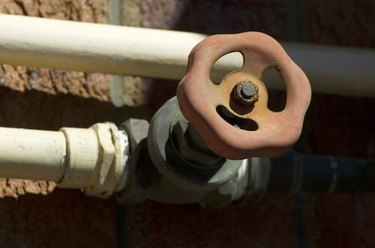Things You'll Need
PVC primer
PVC glue
Teflon tape
2 wrenches
Screwdriver

There are several ways to connect PVC pipe to brass pipe. Mechanical pipe connections using threaded joints are the most secure. Compression pipe connectors using rubber seals and locking nuts are the next best solution. Rubber pipe adaptors, often called hub or no-hub fittings, use stainless steel bands to secure each pipe connection, their most common applications are for use on none-pressurized drain-waist and vent piping. There are many epoxy-based chemical products on the market; however, they're not recommended for use when joining PVC and brass pipe fittings.
Step 1
Connect a female adaptor on the PVC pipe with primer and glue. Wrap the threads of the brass pipe with Teflon thread tape several times. Screw the two together by hand. Hold the brass pipe with a wrench, and with another wrench tighten the PVC fitting on the brass pipe.
Video of the Day
Step 2
Slide one compression nut on the PVC pipe and one on the brass pipe. Attach a rubber seal on each pipe. Fit both pipes into the coupling until they meet in the middle. Screw each nut onto the coupling by hand. Holding the coupling in the middle with a wrench, tighten the nuts with another wrench.
Step 3
Loosen the metal bands of a rubber no-hub coupling with a screwdriver. Insert the end of the PVC pipe in one end, and end of the brass pipe in the other until both meet in the center. Tighten the bands evenly with a screwdriver.
Tip
If you use a pipe joint paste, make sure is rated for both PVC and brass pipe.
Warning
Do not over-tighten the joints--you might strip the pipe threads and ruin the fittings.
Video of the Day